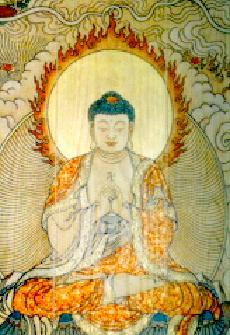HOW SOULS COME INTO BEING

The Buddha
Question
Could you please explain to me how human and non human souls come into being? I had always thought that every soul had evolved from a single celled organism and then worked its way through the genetic tree.
-- Paul, United Kingdom
Answer
My explanation was given by the Buddha, the Enlightened One. Other great masters from other world religions also gave similar answers, but I find the Buddha's answer, recorded in Buddhist sutras and retold numerous times by Buddhist masters, to be the clearest.
Originally, there is (as it always has been, and will always be) the Universal Consciousness. Different peoples call this Universal Consciousness by different names, such as God, Tao, Brahman and the Ultimate Truth. Buddhists call it Tathagata, which means “Suchness”. “Tathagata” is in Sanskrit; in Chinese it is “Ju Lai” (written as “Ru Lai” in modern Romanized Chinese).
There is no differentiation in Tathagata; it is just a continuous oneness. From another perspective, it is void or emptiness. In Sanskrit, it is called “sunyata”; in Chinese it is “kong” (pronounced like “khung”). Tathagata or sunyata is infinite and eternal, and it is peace, freedom and bliss.
There was (or is — tenses fail to function meaningfully in cosmic context) also original ignorance. Because of original ignorance, countless puny portions of Tathagata imagined themselves to be separated from each others. There were (or are) the original souls. This was the first transformation from the transcendental to the phenomenal. In Taoist term, this was the transformation from Wuji to Taiji, or from the Great Void to the Cosmos.
Through countless millennia in a tiny spec of the cosmos we call our world, these countless souls have evolved into human and non-human souls. Because of various sets of conditions, human souls have been conditioned through countless millennia to view this tiny spec of Universal Consciousness as our phenomenal world.
In other words, instead of experiencing Tathagata as a continuous unity, it is now perceived by us, humans, as differentiated into myriad phenomena like mountains and clouds, elephants and distant stars. Actually there are no mountains and clouds, elephants and distant stars, but due to the conditions we are in we perceive them as these phenomena.
One important set of conditions are our senses, including our intellect. The word “phenomena” means appearances. Because of the way our intellect, eyes, ears, etc have been conditioned through millennia to interpret cosmic energy (or, in scientific terms, electromagnetic waves) the way they now do, we interpret some energy as mountains and some as distant stars, etc.
Because of their different conditions, other non-human souls, such as those of fairies and one-cell organisms will interpret the same energy very differently. A fairy, for example, may perceive what appear to us as an elephant, as thin air; and a one-cell organism may perceive what appear to us as a cloud, as a galaxy.
Why have some souls evolved to become human, while others have evolved to become non-human, like fairies, elephants and one-cell organisms? It is because of three variables, namely their karma, their state of mind, and their last thought at their previous physical death.
Humans are at a high state of soul development, having worked their way up from low states like those of spirits, animals and one-cell organisms. But their development is spiritual, not genetical. In principle, a one-cell organism can become a human in its next life, but in practice this is most unlikely.
To be a human is a very rare opportunity, having developed spiritually through countless lives. The Buddha has often advised that we must not waste such a rare opportunity. We should make use of this rare opportunity to cultivate to attain the highest spiritual fulfilment. If we are not ready for such a most noble task, we should at least lead our life meaningfully.
The above is taken from Question 1 Feb 2002 Part 1 of the Selection of Questions and Answers.
LINKS
Courses and Classes
